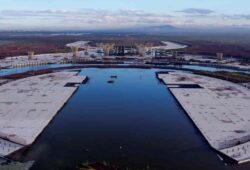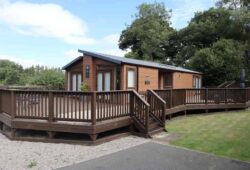We often encounter the question, “Where is the power converter in my RV” from several friends and family.
Why does it matter knowing where your RV’s power converter, anyway?
For one, you want to make sure that your power is in good working condition when you are out on your camping trip. After all, it is always more convenient to have access to power when you are in your mobile home for the night.
So where is this power converter? And how can you make sure it is working well?
This post will clear this question out and help you discover how exactly your RV’s power converter works and why it matters. Let’s dive right into it!
Contents
Where Is The Power Converter In My RV? Know The Basics
Generally, your RV converter gets the 120-V power from the main source, then this gets converted to recharge the batteries in your camper.
There are two different power systems in your vehicle. They both do one important job of making sure everything in the RV runs as smoothly as possible.
With your converter and inverter, you can have a steady supply of power to last you throughout your trip. Whether you need to keep your AC unit running, watch TV, have your fridge doing its job of cooling your drinks and keeping your food fresh, your power converter does the behind the scenes job for all of these tasks.
Every RV has a different spot for the power converter.
However, the most typical spot is close to the control panel. If you have a good look at the control panel, you should be able to see a tiny fan or vent right there. And… voila! It means your converter should not be too far away from this location.
Perhaps you have just bought a new trailer or you traded in your old one for a slightly used RV. The next step is to make sure that you know exactly where to find the power converter.
The RV converter takes the 120 volt power from when you are plugged into shore power and converts it to power to recharge your RV batteries. In every trailer, the converter can be located in multiple locations. The most common spot to find your converter is near your control panel. You will likely see a small vent or fan near your control panel that is an obvious sign that your converter is near.
Most power converters are equipped with a system that keeps them cool. This is why they are often positioned in a location close to a fan or vent.
But in some cases, it may not be in this particular spot. So, you may want to do some experiment by turning your lights and AC off and wait for the buzzing sound. Follow where this noise is coming from, and that is where your power converter is located.
If these tips don’t work, a quick and easy way to know for sure where your converter is found would be to contact the manufacturer. They should be able to tell you exactly where the converter is, so you can make necessary work and adjustments for the future.
Understanding The Purpose Of Your Power Converter

Your power converter does a lot of jobs that are crucial to day to day operations in your RV.
For instance, you can count on it to run all of your DC appliances and charge your RV battery.
You can even keep charging your battery as you are plugged to the shore power. What this means is that as you plug at a campground or a generator, your battery can remain charged the whole time.
Overall, your power converter is a very important part of your RV. It is powerful enough to keep your thermostats, lights, refrigerator, and vent fans working.
Most importantly, when your battery is working well, you can stay comfortable and have all the convenience you need even when far away from home.
Thus, it only makes perfect sense to keep your power converter in check to prevent any inconveniences when out and about.
Is It A Power Converter Or An Inverter?
Perhaps you thought you have finally found your power converter only to realize it is your inverter.
What is the difference between the two?
Do keep in mind that every RV comes with a converter and an inverter. They may serve different functions but they both provide your rig with power.
What the inverter does is to obtain power from the battery. This is then used to run appliances and electrical components in the vehicle. The 12-V power is converted to 120, which powers your appliances.
Unfortunately, it is not enough to run every single thing in the RV.
But you can definitely run the sliding mechanisms, lights, and similar things. Certain aspects and components of your vehicle can run, thanks to the inverter.
On the other hand, a converter obtains shore power, which is then converted to recharge the RV battery. This way, you have a supply of power for future use. When you have a converter, you can restore the battery, as long as it is plugged to power such as solar, generator or a campground hookup.
Both converter and inverter give power to your RV. But depending on the number of appliances that you need to run, it may be worth swapping out a larger converter that can provide more power.
What’s The Next Step?
Once you have located your power converter either from following our directions here or after contacting your manufacturer, here’s is the next thing you need to do:
Determine if it is working well.
Keep in mind that your converter is a very important resource in your vehicle. It supplies power to your appliances, so if there are issues, it is best to do something about it right away before things take a turn to the worst.
Keep your eye out for these signs that your converter needs repair or replacement.
- Electronics are malfunctioning
- Lights are dimming
- Fridge does not reach its optimal temperatures
When you are absolutely certain that these issues are present in your RV, then you may have to contact an expert to take a look at your power converter.
Some folks decide to install a new converter themselves. However, it is not ideal, especially if the installation was not done right. This can lead to serious concerns such as damaging your electrical system. When this happens, you are in a far greater issue than having a malfunctioning converter.
Bottom Line
We hope this answered your question, “Where is the power converter in my RV.”
Once you have discovered where exactly your power converter is, be sure to check its condition. If the signs listed above are present, it may be worth having a professional take a look at the converter.
The replacement cost for a converter can go anywhere from $200 to as much as $1400. However, it is an important investment worth making for your own safety, convenience and peace of mind.
So, be sure to determine where exactly your power converter is, check if it is working at an optimal condition, and take the next steps in case an issue is detected.




